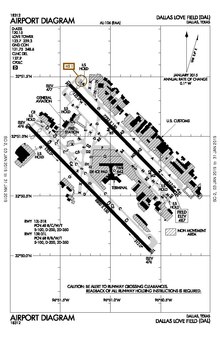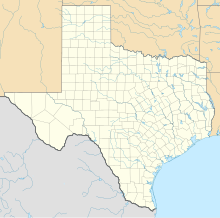Love Field Airport
| Dallas Love Field | |||||||||||||||
|---|---|---|---|---|---|---|---|---|---|---|---|---|---|---|---|
 |
|||||||||||||||

2013 aerial photo
|
|||||||||||||||
| Summary | |||||||||||||||
| Airport type | Public | ||||||||||||||
| Owner | City of Dallas | ||||||||||||||
| Operator | Dallas Department of Aviation | ||||||||||||||
| Serves | Dallas–Fort Worth–Arlington | ||||||||||||||
| Location | Dallas, Texas, USA | ||||||||||||||
| Focus city for | |||||||||||||||
| Elevation AMSL | 487 ft / 148 m | ||||||||||||||
| Coordinates | 32°50′50″N 096°51′06″W / 32.84722°N 96.85167°WCoordinates: 32°50′50″N 096°51′06″W / 32.84722°N 96.85167°W | ||||||||||||||
| Website | www.dallas-lovefield.com | ||||||||||||||
| Maps | |||||||||||||||
 FAA airport diagram |
|||||||||||||||
| Runways | |||||||||||||||
|
|||||||||||||||
| Statistics (2016) | |||||||||||||||
|
|||||||||||||||
|
Source: Federal Aviation Administration
|
|||||||||||||||
| Aircraft operations | 224,193 |
|---|---|
| Passenger | 15,562,738 |
Dallas Love Field (IATA: DAL, ICAO: KDAL, FAA LID: DAL) is a city-owned public airport 6 miles (10 km) northwest of downtown Dallas, Texas. It was Dallas' main airport until 1974 when Dallas/Fort Worth International Airport (DFW) opened.
The corporate headquarters for Southwest Airlines is located at Love Field. The airport is also a focus city for Southwest as well as for Virgin America. Seven full-service fixed-base operators (FBOs) provide general aviation service: fuel, maintenance, hangar rentals, and charters. Some also provide meeting rooms, car rentals, limousine service and restaurants.
Dallas Love Field is named after Moss L. Love, who while assigned to the U.S. Army 11th Cavalry, died in an airplane crash near San Diego, California, on September 4, 1913, becoming the 10th fatality in U.S. Army aviation history. His Wright Model C biplane crashed during practice for his Military Aviator Test. Love Field was named by the United States Army on October 19, 1917.
Dallas Love Field has its origins beginning in 1917 when the Army announced its intention of establishing a series of camps to train prospective pilots after the United States entered into World War I. The airfield was one of thirty-two new Air Service fields. It was constructed just southeast of Bachman Lake, and it covered over 700 acres and could accommodate up to 1,000 personnel. Dozens of wooden buildings served as headquarters, maintenance, and officers’ quarters. Enlisted men had to bivouac in tents.
...
Wikipedia

